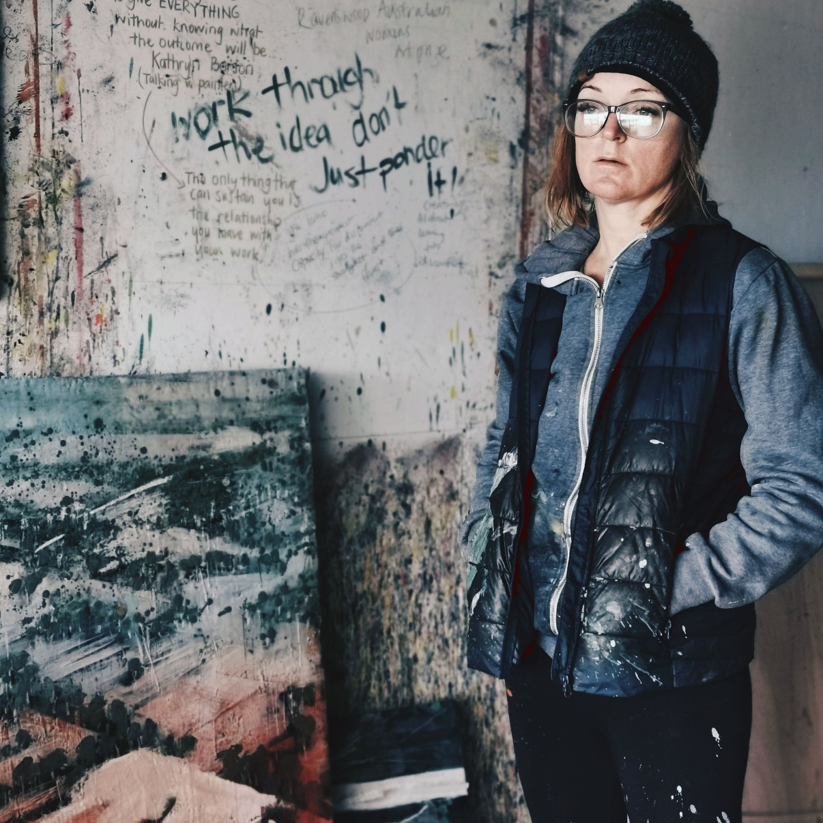Carly Le Cerf Painter
Can you explain the different mediums you use in your work?
My work would most accurately be described as mixed media. My staple materials are beeswax, oil and natural pigment, but I have also been known to use ink, charcoal and even bitumen. I use the beeswax in its molten form (encaustic), taking advantage of its fluidity and textural qualities.
Discuss how important aerial painting is to an Australian, particularly a Western Australian?
Australia is a gigantic continent, with vast expanses of terrain that can only really be fully appreciated from a great height. Of course, I can’t speak for others but, looking at the Western Australian landscape in this way enables me to take in the entirety of the landscape.
Colour is also very Australian in your work. Use two works to expand on this.
Our dry country
The colour of the landscape and its seasons directly influence my work. The dynamism of weather and climate also impact greatly. ‘Mudpies’, was created in the centre of what is still the most devastating drought Australia has seen. For me, burnt umber tones against a promising deep, Payne’s Grey sky do the drama justice.
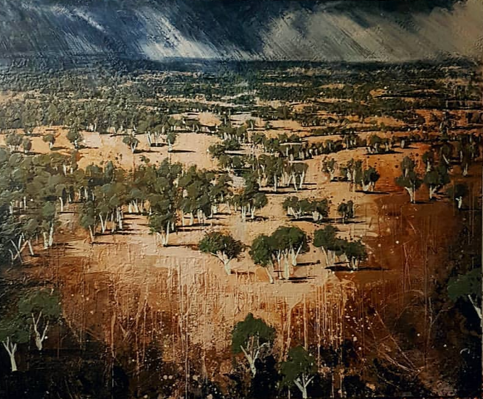
Mud Pies, 165 X 142 CM, Oil, wax and pigment on board (2019)
Our green country
‘Emotionscape’, was painted entirely form memory. I am lucky enough to live in an agricultural area which provides me with an endless stream of inspiration throughout the year. From my studio I can see an expanse of hills, paddocks and tree lines which peter out into the distance. With heavy rainfall around wintertime, the great southern offers plenty of opportunities to play with the blues and greens to prevalent during that time of the year.
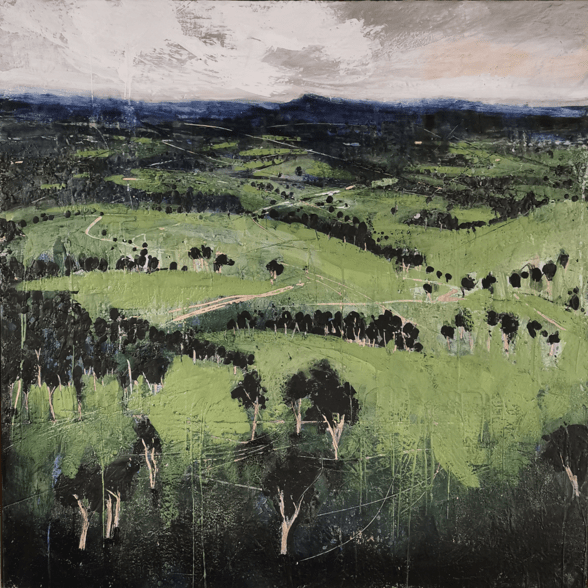
Emotionscapes, 100 X 100 cm Oil, wax and pigment on board (2019)
Line, especially straight lines in your work shows the impact of man on the landscape, discuss.
I am fascinated with the contrast between the organised structure seen in agricultural landscapes and the rugged, chaos of the natural bushland. I also very much enjoy the opportunities that these lines give me to explore perspective. With the mediums I use also being fluid and organic in nature, I enjoy the visual tension the straight lines create.
Your studio is at Mount Barker in Western Australia.
Mount Barker is a small town 363 kilometres (226 mi) south-east of Perth in the Great Southern region of Western Australia. My home and studio are perched on a hill (Mount Barker Hill) with 50 kilometres of uninterrupted views across the agricultural landscape to Albany. It was only after I moved to the location 10 years ago that I began painting works in aerial perspective. At first it wasn’t a conscious shift but now I am very aware that my daily view has led me in the direction that I am currently painting.
You comment, ‘Drawing is my meditation’, Expand on this.
For me drawing and meditation are one and the same. Drawing, especially if it is challenging, requires concentration, which enables me to quiet my busy mind and find a focus which blocks out irrelevant thoughts and sounds, much like meditation.
Since I practice both drawing and meditation daily, I am, able to sustain focus for quite a long period of time and I feel recharged at the completion of the drawing.
Horizon line is always at a different plain, how do you decide?
I always refer back to the rule of thirds, depending on what I am wanting to focus on. Sometimes it’s the sky, so the horizon line is very low and other times it’s the land, so my horizon line is either very high or non-existent, like in my aerial works. Placing the horizon line along either the top third line or the bottom, ensures a balanced composition and enables a viewer to interact with it more naturally. Using the rule of thirds works with an inherently natural way of viewing rather than working against it.
Explain how you use wax in your art?
As previously mentioned, I use my beeswax in its molten form. This technique is known as Encaustic. Encaustic painting involves using heated beeswax to which coloured pigments have been added. I then apply the liquid, coloured wax to my plywood panel. A lyricism inhabits the act of building up and carving back the wax; a dance between control and unpredictability, revealing a sculptural quality. I am inspired by the way we sculpt our environment and encaustic is a fabulous medium to explore this element.
You do commissions. Please take two that have been very different and give your, incite, into the process of both commissions.
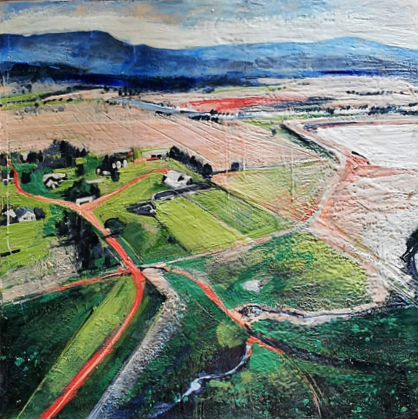
Tasmanian Homestead Commission (2019)
This artwork was created for a client in Campbell town in Tasmania, have never been to Tasmania but was instantly drawn to the drone photo sent to me as inspiration for a painting. It is very different to create a landscape that I haven’t personally experienced so in this case my main objective was accuracy and a bright colour palette.
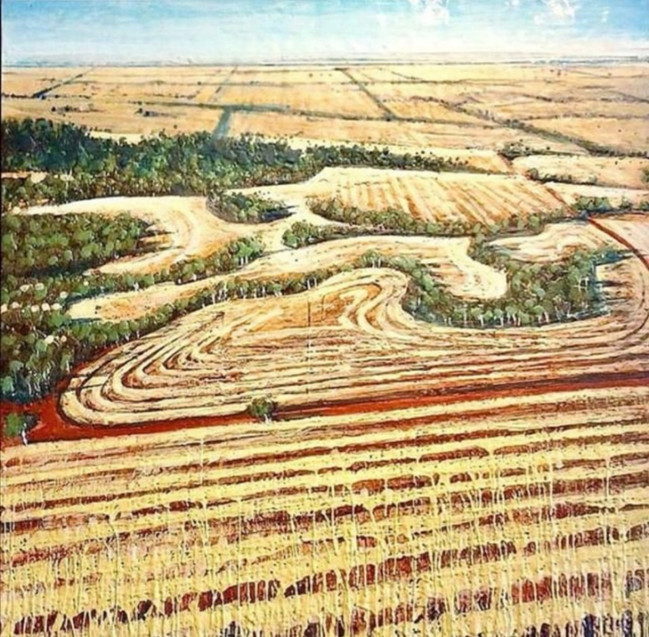
Mullewa, WA Farm Commission (2019)
I created this artwork for a friend with whom I had connected through our shared love of the landscape. Having grown up in the wheatbelt of Western Australia, my friend wanted a memento and a reminder of her childhood to be hung in her current home in York, WA. I was sent a few drone images to work from and after discussions about what she wanted; I began creating the work. The very different component of this commission was that the image provided to me was not taken during the dry, harvest of the canola, but rather when the fields were green and had not yet flowered. I had the challenge of using the landforms and painting the landscape in a completely different season. I enjoyed the whole process and felt it gave me more freedom to create something quite unique.
You work in isolation; how does this effect your work?
I enjoy the quiet and solitude of my remote little studio and I can’t say I have ever felt lonely. My work requires focus and it is also quite physically demanding so I have little time to chat with others or worry about what is going on in the outside world. I have worked in shared studio spaces before and I found it very disruptive to my process. Because my work has such an emotional component, I feel that solitude is required to fully express myself.
Tell us about your art training and how you have developed from that point.
My formal art training started in 1998 at the Carine College of TAFE, where I studied an Advanced Certificate in Art and Design. This was a broad course which gave me the opportunity to dabble in many different mediums. Even back then, drawing and painting were my preferred mediums and I continued to develop my interest in subsequent years. I went on to study a Bachelor of Fine Arts, majoring in Painting, at Edith Cowan University in Western Australia. Since graduating in 2000 I have been committed to regular practice, eventually embarking on a professional painting career after my children were born in 2006. I spent 5 years after graduating in the Pilbara which really ignited my love of the landscape. I have been obsessed with it since!
Rain! Explain how you show the utter joy in seeing the rain in your work?
With all eyes on the weather in Australia, it was inevitable that I would explore the theme in my work. I have always painted seasonally, being directly inspired by the landscape at the time of painting. I have many friends around rural Australia who have struggled terribly with the drought and wanted to bring some rain into everyone’s lives, something everyone (including me) was yearning for. I love the misty atmospheric quality of rain on our parched landscape.
You use the idea, of using a particular place and paint it over and over. Discuss.
An everyday fascination with the agricultural landscape was the main inspiration for this body of work which I titled, ‘7 Days’. Living in the Great Southern landscape of WA, I am always subconsciously gathering the shapes, flashes of colour and composition of the agricultural patterns that surround me. I wanted the focus to be on the sky and how the light effected the yellow canola field.
When your works are purchased through you, personally how do you package and send the work?
Packing my work takes time and care, especially since I live so far away from my galleries and clients. I personally pack my works, making my own boxes and arranging freight all over Australia. Firstly, I wrap the work in brown paper, then add corner protectors and bubble wrap. I don’t like to just wrap my work in bubble wrap as it can mark the surface of my work. I then custom make a box from recycled glass boxes. I arrange freight through the local Star track depot who can ship Australia Wide. To ensure works arrive safely and to protect my client’s interests, I always purchase insurance for my works and provide tracking updates. Thankfully I haven’t had any big issues and works arrive safely in the hands of their new owners.
Take different farming practices you use in your work. Vineyards, wheat and canola paddocks. Although man made these are landscapes of your environment. Discuss.
I think that these have been my inspiration for a few years now because they surround me and make up my immediate surroundings. Mount Barker is both a farming and wine region so there is plenty of inspiration.
I have also travelled extensively around Australia and taken inspiration from cotton fields. I enjoy the formal windrows of crops and the bold contrasts between the crops and the sky. I think if I lived in the outback again my work would probably shift. I tend to create what is around me.
Contact:
Carly Le Cerf
Email: carly.lecerf@gmail.com
Deborah Blakeley, Melbourne, Australia
Interview by Deborah Blakeley, March 2020
Think a colleague or friend could benefit from this interview?
Knowledge is one of the biggest assets in any business. So why not forward this on to your friends and colleagues so they too can start taking advantage of the insightful information the artist has given?
Other artists you may be interested in:


